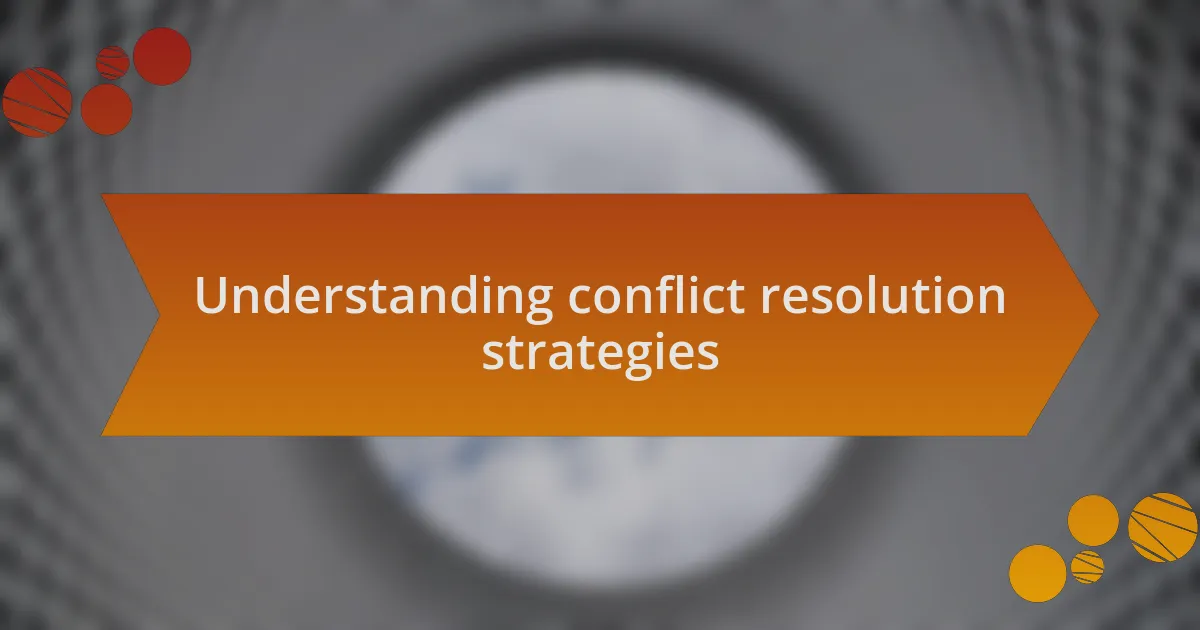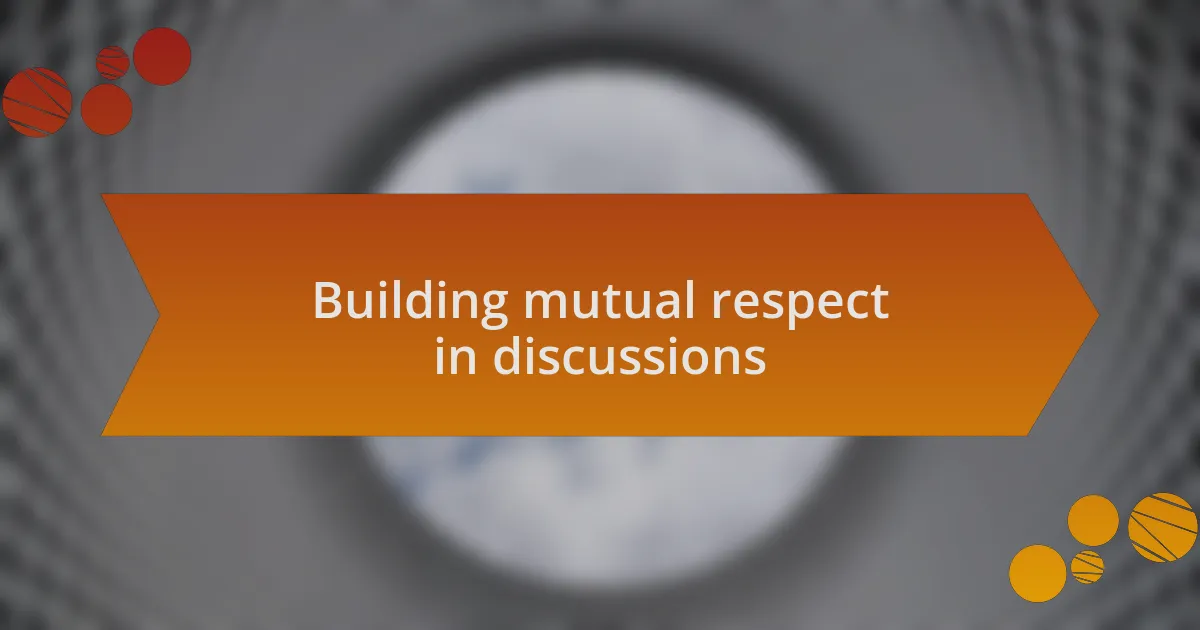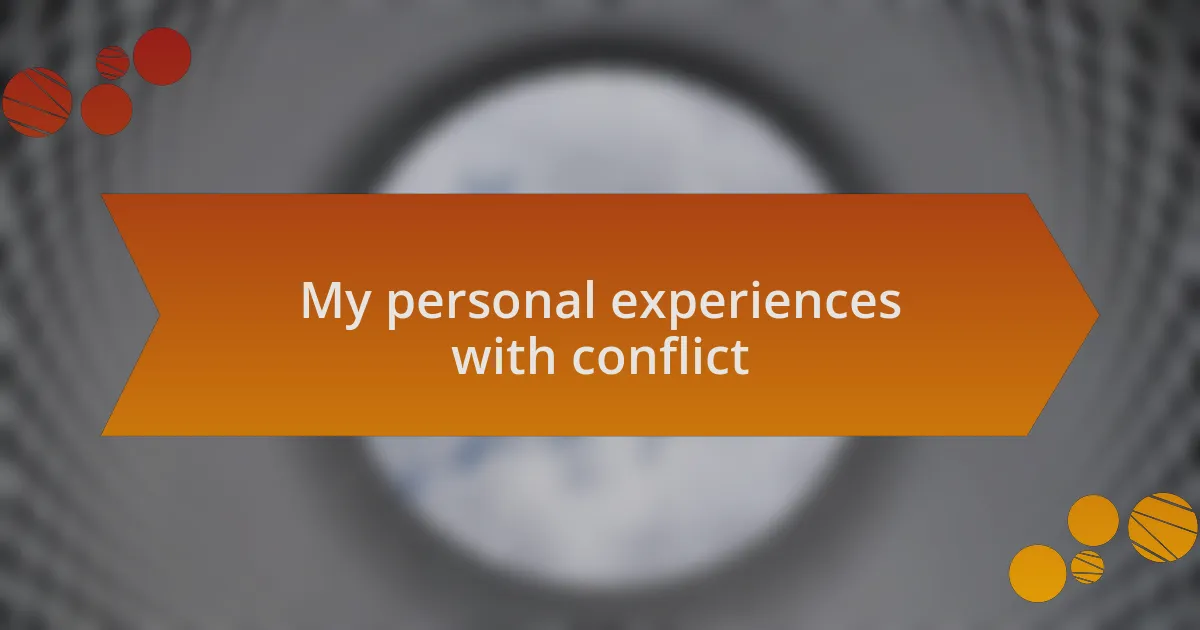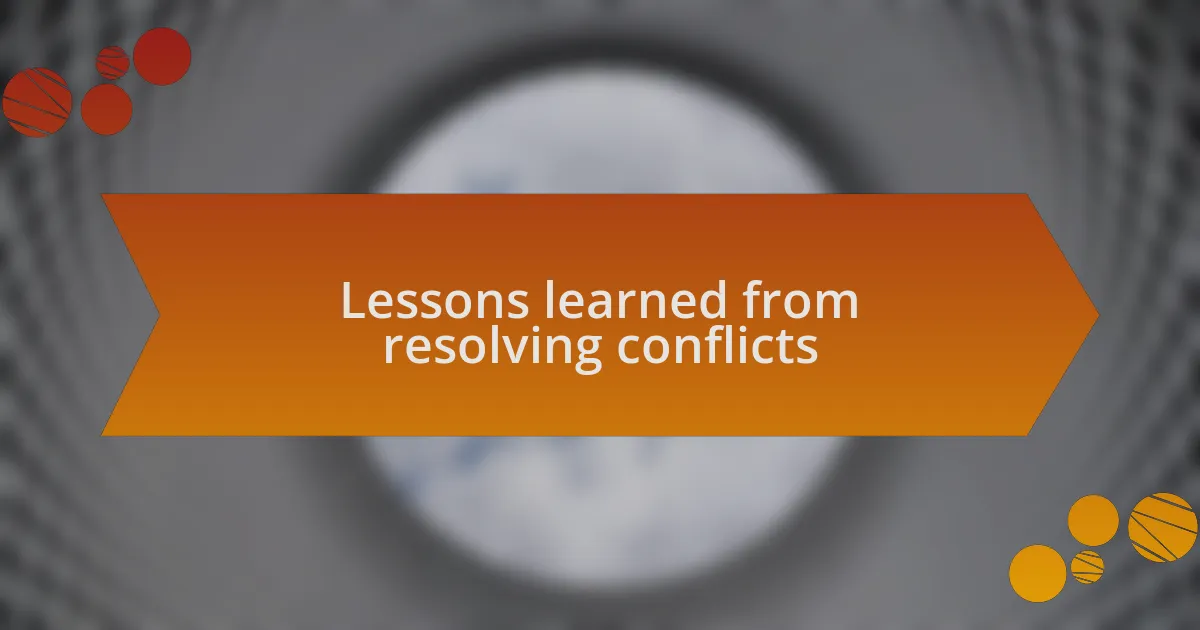Key takeaways:
- Effective conflict resolution involves active listening and finding common ground, enabling deeper understanding and collaboration.
- Incorporating humor can ease tensions and foster cooperation during heated discussions.
- Building mutual respect and prioritizing listening create a productive dialogue and promote openness among participants.
- Addressing emotions and vulnerabilities can transform conflicts into opportunities for deeper connections and learning experiences.

Understanding conflict resolution strategies
When we think about conflict resolution strategies, it’s essential to recognize that each situation is unique. I remember a workshop where two artists clashed over the interpretation of a shared theme. The tension was palpable, and I found myself wondering, how can we transform this discord into creativity? This moment drove home the idea that effective conflict resolution often involves finding common ground and encouraging collaboration.
Listening actively is one of the most powerful strategies I advocate for when navigating conflicts. During one workshop, I noticed a participant getting frustrated with another’s perspective. Instead of stepping in immediately, I encouraged them to articulate their thoughts. It was amazing to witness how simply giving each other the space to share their viewpoints led to a deeper understanding and ultimately, a richer discussion. Isn’t it fascinating how the act of listening can bridge gaps that words alone often widen?
Moreover, incorporating humor can lighten heated exchanges. I recall a particularly tense situation where the energy was thick, and I decided to break the ice with a lighthearted remark. It prompted laughter and eased the atmosphere, making it easier for everyone to approach the disagreement with fresh eyes. This experience taught me that sometimes, a little levity can go a long way in fostering cooperation. Isn’t it worth considering how we might use humor as a tool in our own conflict resolutions?

Techniques for effective communication
When it comes to effective communication, clarity is paramount. I remember a workshop where an unclear agreement led to confusion. By taking a moment to clarify expectations and terms, everyone felt more aligned. Isn’t it amazing how a few clear words can transform misunderstandings into a shared purpose?
Another technique I’ve found invaluable is non-verbal communication. During one intense discussion, I noticed that participants’ body language said more than their words. Small gestures, like nodding or maintaining eye contact, signaled engagement and openness. Reflecting on those moments made me realize how much we can convey without saying a single word. Do we always pay attention to how our bodies express our willingness to connect?
Lastly, asking open-ended questions can foster deeper dialogue. In a recent workshop, I encouraged participants to explore their feelings about a controversial topic. By asking, “What does this theme mean to you?” I invited them into a space of self-expression. The responses were rich and layered, revealing insights that might have remained hidden otherwise. Don’t you find that the right question can unlock a treasure trove of understanding?

Building mutual respect in discussions
Building mutual respect in discussions is essential for fostering a productive dialogue. I remember a time when a disagreement arose during a workshop, and I had to pause the conversation to remind everyone of the importance of respecting each other’s viewpoints. This simple acknowledgment transformed the atmosphere; there was suddenly a sense of camaraderie, where we valued what each person brought to the table. Have you ever felt a shift in energy just by reiterating respect for differing opinions?
Listening is just as crucial as sharing our thoughts. In one particularly heated discussion, I noticed a participant withdrawing because others weren’t fully hearing her perspective. By actively encouraging her to express herself, I witnessed not only her relief but also how the group became more receptive and attentive. It struck me then: when we prioritize listening, we open the door to deeper understanding. How can we better cultivate that listening culture in our discussions?
Finally, I find that sharing personal experiences can bridge gaps and foster respect. In a workshop on creative expression, I shared a vulnerable moment from my artistic journey, which resonated with others. This shared vulnerability created an environment of trust and openness, inviting more participants to share their own stories. Isn’t it fascinating how authenticity can break down barriers and build mutual respect among diverse individuals?

My personal experiences with conflict
Conflicts, although challenging, have often turned into pivotal moments in my workshops. I recall a particularly tense exchange during a session on collaborative art creation. A strong disagreement surfaced about the direction of the project, with emotions running high. It was in that moment I realized that addressing the conflict head-on, rather than skirting around it, invited a resolution that could spark creativity rather than stifle it.
There was another time when I faced tension between two participants who couldn’t see eye to eye on a shared art piece. I facilitated a brief side conversation with each of them, allowing them to express their frustrations. By encouraging open dialogue, something magical happened: they began to see each other’s perspectives. Have you ever experienced the relief that comes when people feel genuinely heard? It made me appreciate the power of facilitating rather than just observing.
Sometimes, conflicts arise from misunderstandings rather than true disagreements. I once found myself in a situation where a participant felt slighted by a comment I had made. Rather than dismiss their feelings, I took a moment to acknowledge the impact of my words. We ended up having a heartfelt conversation that cleared the air, transforming a potential rift into a learning experience. That’s when it struck me: vulnerability in conflict isn’t a weakness; it’s often the key to deeper connections. Isn’t it fascinating how addressing emotions can mend relationships?

Lessons learned from resolving conflicts
Resolving conflicts has taught me that patience and active listening are invaluable tools. During a workshop where disagreements simmered, I found that taking a step back and allowing moments of silence led participants to reflect on their feelings. Have you ever noticed how quiet can create space for understanding?
One particular incident stands out; I facilitated a group where differing artistic visions clashed. By using visual aids, I encouraged everyone to express their ideas non-verbally before discussing them. The breakthrough came when they realized their interpretations complemented each other rather than clashed. I learned that sometimes, stepping outside of verbal communication allows for a richer exchange of ideas.
Another key lesson is that empathy can be transformative in conflict situations. I remember guiding a discussion where one participant broke down in tears over perceived exclusion. Seeing their vulnerability shifted the atmosphere entirely. It wasn’t just about resolving the issue at hand; it was about creating a safe environment for honest emotions. Isn’t it remarkable how compassion can turn a tense moment into a bonding experience?